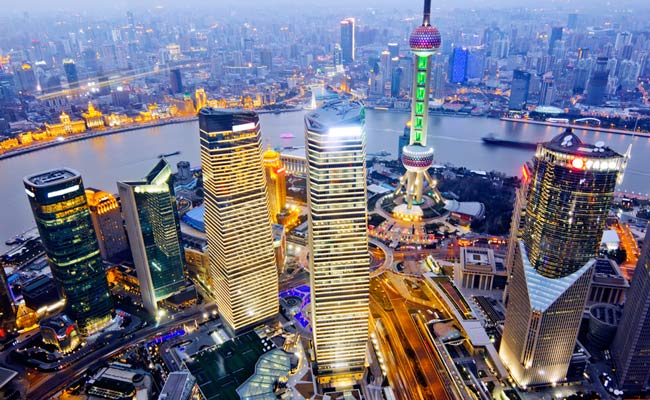The popular notion is that state-owned enterprises are very powerful in China. To what extent is that true? Are fears of China’s state capitalism overblown?
It’s not hard to see why the West is afraid of the power of China’s state capitalism: state-owned firms are gobbling up private ones at home, buying up global resources and ‘destroying’ the world’s business order. And even when the headline-grabbing firms are not government-controlled, like in the case of Alibaba or Shuanghui (the pork producer that purchased Smithfield last year), they either have ties to the elite military families or hidden financial support from state-owned banks.
It’s a widespread notion that China’s state-owned companies are so powerful that they determine the country’s economic success and spearhead its global ambitions. While it’s true that state monopolies do exist in almost all key sectors (it’s a “socialist market economy” after all), and the government still keeps a tight grip on a lot of industries, the communist state may not be as omnipotent as you may think. If you take a closer look at the statistics of the Chinese economy, you’ll realize that the dominance of China’s state-owned sector is oftentimes overblown by the media; and the growth miracle China has managed to achieve in the past three decades very much depends on its thriving private sector, which now accounts for the vast majority of China’s industrial output.
This is the key message from Nicolas Lardy’s new book, Markets over Mao: The Rise of Private Businesses in China. A long-time China watcher and the Anthony M. Solomon Senior Fellow at the Peterson Institute for International Economics, Lardy argues that China is on track to become a more market-driven economy and there’s no evidence that state-owned firms are enjoying a return of prominence. In this interview with CKGSB Knowledge, Lardy dismisses some common misconceptions about China’s state economy and provides a detailed look at the country’s reform agenda.
Q. Can you start with explaining what’s considered private and what falls into the state-owned sector in China?
A. The question of state versus private has always been complicated in China because of the various hybrid forms of ownership that have existed throughout the history of the People’s Republic. But I think this has begun to be clarified because the statistical authorities are now classifying firms based on what they call ‘control’, or kong gu (in Chinese).
This is very important because there’s a very large universe today of limited liability companies, and without looking into their ownership structure, it’s very hard to figure out if they’re really state-controlled or privately-controlled. So the criteria is, if a limited liability company has a sole majority or dominant state owner, then it is classified as state controlled; and similarly if the sole majority or dominant owner is private, then it falls into the privately controlled category. So these are the broad criteria that are used, and this is true for the output data and also for some of the lending data that is now being published by the People’s Bank. And I think this a good metric.
Q. There have been many discussions about how powerful state capitalism is in China. What is your perception?
A. I think particularly in the West and the US that I’m most familiar with, there are a number of misconceptions about the Chinese economy. One is that the state is very dominant, that it’s the major part of the economy. Another misconception is that state firms are all very monopolistic, that they have a lot of market power, and that they earn what some people characterize as “astronomical” profits, and this enhances the whole role of the state. A third misconception is that the state is very large, and has a large, powerful bureaucracy. A fourth misconception is that the state enterprises absorb most of the lending from the banking system and that private players get squeezed out or starved for capital. And a final misconception, I think, is that somehow there was a resurgence in the role of state companies during the period when President Hu Jintao and Premier Wen Jiabao were in power—state firms were very important in the Maoist era, that they faded away under Deng Xiaoping, and that then they enjoyed a return to prominence in the period, say, from 2003 to 2013.
But when you look at the evidence to see whether or not these thing are true—these widespread conceptions or consensus view—it turns out is not true. In terms of the dominance of state firms, in the industrial sector state firms used to be totally dominant and today they only produce a quarter of output.
In manufacturing, they only produce a fifth of output. The real source of growth in the manufacturing sector has been private companies. Similarly, in terms of employment, state-owned companies used to be responsible for a very, very large share of employment in urban areas. This has fallen dramatically, and the total number of people employed in state-owned enterprises and state-controlled enterprises today only accounts for about a little more than 10% of the urban workforce. Most people are working for private companies. More importantly, if you look at the growth of the labor force over the last three to four decades, almost all the growth is accounted for by the expansion of private businesses.
On the credit question, one of the reasons private companies have been able to grow fairly rapidly is that they have gotten better access to credit in recent years. It is true that historically state-owned firms did absorb most of the credit, but I think in the last 10 years that has changed. If you look at the most recent data for the last three years… [of] flow of money to enterprises, state companies are getting about a third of the money and private firms are getting a little bit more than half. So the empirical evidence doesn’t really support the view that state companies have complete control of credit.
And finally, on the resurgence of state companies—particularly if you look at the manufacturing sector—private companies grew twice as fast as state companies throughout the 10 years that Hu Jintao and Wen Jiabao were China’s two main leaders. So it was a continuation of the trends of an early period when private companies, particularly in the industrial sector, have just simply grown much more rapidly.
Q. Why do you think the private sector has flourished in China?
A. The private sector has flourished primarily because it’s more efficient. The return on assets is much higher. Most investment in China is financed from retained earnings. We have a natural inclination to focus on what the banks are doing, how much money’s being raised through the equity market or the debt market; but most investment is being financed from retained earnings, and if you have a much higher return on assets in the private sector, they’re going to have more retained earnings, which they reinvest, and that allows them to grow faster. And in more recent years they’ve also gotten somewhat better access to bank lending.
Q. One popular perception is that SOEs enjoy extremely cheap credit from the banks, but you have some different findings.
A. In my book I actually look at that in some detail. And the idea that state companies are getting cheaper capital than private companies really turns out not to be the case.
There’s a lot of evidence that the difference in the interest rates that state and private firms pay is very, very small. There are a number of studies that have been done that argue that state firms pay a lot less. But they have calculated the interest rates that the state companies paid on a fundamentally flawed methodology.
They’ve looked at listed companies, and they’ve looked at what they’re paying on their interest payments, and they divide that into their liabilities. One of these studies argues that state companies [have] only [been] paying 1.7% in recent years, whereas the average bank lending rate is 6% or 7%. But they made a fundamental flaw in the denominator of liabilities: they have a huge share of non-interest-bearing liabilities. Companies have payables, wages that are due, other payments that they have to make, so they’re a liability on their balance sheet. But they’re not paying interest on them. So once you correct for the fact that only a small share of any firm’s liabilities are interest bearing, it turns out that these state companies are paying 6% or 7% just like everybody else.
It is true that some private companies are forced into what we would call shadow banking, or even worse the underground banking sector, and interest rates are much higher there. But to the extent to which private firms are able to access bank loans, they’re not paying much higher rates.
Quite frankly there’s a good reason for it. Private companies have a much higher return on assets, and if you look at their interest coverage ratio today—that is, their earning relative to their interest payments—their coverage ratio is more than twice that of state firms. State firms have a relatively low return on assets, so their interest coverage ratio, which is a very good indicator of credit worthiness, is not very high. So there’s no reason for banks to charge more to private companies they’re lending to, because in fact they’re more credit worthy.
(Watch the video below)
Q. Speaking of credit, how will interest rate liberalization change the way enterprises are financed?
A. I still think interest rate liberalization, and particularly the liberalization of deposit rates, would be very important, because China has been for a number of years in a very capital-intensive growth process.
Because the central bank has held down deposit rates, banks have had a cheap source of funding. And borrowers have shared in that cheap source of funding because there’s enough competition in the banking sector. One of the reasons the investment rate is so high is that the cost of borrowing money from the banking system is too low. So liberalization of deposit rates, if we look at what unregulated rates are—like money market funds, wealth management products—they tend to be 200 or 250 basis points higher than bank deposit rates. So I think if the ceiling on bank deposit rates were gradually phased out, banks would have to pay more for their funds; and if they pay more on their liabilities, they’re going to seek to earn more on their assets. So they will try to charge higher interest rates on their loans.
This will be very positive for China’s development for two reasons: it will lead to less capital formation, less capital-intensive growth, and I think it will also lead to an increase in the share of lending that is going to go to the private sector, because the private sector is better able to pay higher rates because they’re more productive and have higher returns.
And since the private sector has a return on assets in manufacturing that is three times that of state companies, and in services at least twice that of state companies, the money will flow to firms that can generate better returns. So this will help to sustain economic growth in China, even if the share of resources going into investment comes down. So you can moderate the growth of investment, and still keep the overall economy growing reasonably well if the allocation of bank loans is more efficient.
Q. You once said that the effort to create China’s ‘national champions’ had failed. Why did you say so?
A. I came to the view that the efforts of the State-owned Assets Supervision and Administration Commission (SASAC) had not really worked out very well because the return on assets of these firms has declined very dramatically since the time that SASAC was formed back in 2003. These firms on average now earn only about half their cost of capital. They don’t even earn 4% return on assets, and the cost of capital is in the neighborhood of 7% to 7.5%. So these firms had become a big drag on China’s economic growth, and I think this is recognized at the top of China’s political system because one of the platforms, or one of the components of the Third Plenum reforms, was to eliminate monopolies except for natural monopolies.
And many of the SASAC firms do operate in highly monopolized sectors. A lot of the service sectors are monopolized—upstream oil and gas is monopolized, certainly telecommunications would be the best example—all those telecommunications companies are under the aegis of SASAC. So reducing the monopolies in these areas, increasing competition and allowing more access by private players is seen by the current leadership as a way of maintaining and sustaining China’s economic growth.
Q. Will there be opportunities for private enterprises to go into sectors like power and telecommunications?
A. Well, certainly probably not in power distribution. I think power distribution is what we would call a natural monopoly and I think the State Grid, for example, is going to continue to be one of the dominant players along with China Southern Power Grid. But power generation could be a more competitive sector, and certainly financial services could be a more competitive sector. And the authorities are already beginning to license a number of new completely private banks. Now these will be very small to begin with and they might only be able to operate in limited geographies, but establishing truly private banks for the first time, I think, is an important step forward.
If you look at value-added telecommunications services, private players are already entering into that space and some of the monopoly companies are being required to lease capacity on their wireless networks to allow the expansion of these private players. In the basic wireless service the three companies still have a monopoly position, but in a lot of the value-added telecommunications services, competition is already starting up. That’s a very important sign. Even in upstream oil and gas—the fact that Sinopec is selling off a very large chunk of its distribution business to private firms is a big step forward.
Q. One of the current reforms aims to mix up the ownership structure of SOEs. Do you think it’ll eventually work out?
A. If you look back over the last decade, the hybrid form of ownership has not really been a game changer in China. Yes, some big state firms were corporatized, a number of them got listed on the Shanghai market or maybe some external market like Hong Kong; but the state retained a dominant ownership of those companies, and in many cases at 60% to 70% or even more. And there wasn’t really much change in governance. So I think hybrid governance is a step in the right direction potentially, but if the state is going to remain the dominant owner, it’s not as transformative as it might be.
I’m hoping in this time the share of ownership that transfers into private hands will be somewhat higher. And there’s an opportunity to really transform the operation of these companies, not just simply let private people buy into 20% or 30% of the shares. That will require some fundamental changes. It will require the organization department of the party to step back from determining the composition of the top management of these firms, and let the boards of directors of these companies play that role.
Q. So do you think there will be resistance from officials or the current executives of the SOEs?
A. Well, I certainly think there will be some resistance in some quarters. On the other hand, some of the entrepreneurial people in state companies may even welcome the opportunity to operate in a more competitive environment and demonstrate that they can improve the efficiency of the firms that they’re operating.
I’m not against state ownership, I think what we need is competition. And if state firms can compete with private firms, they should continue to have a large role. On the other hand, if they’re not able to compete over time then they probably need to shrink, and perhaps some of them may be taken over by a more efficient private player. So the key way of getting more efficient allocation of resources is to have more competition.



















